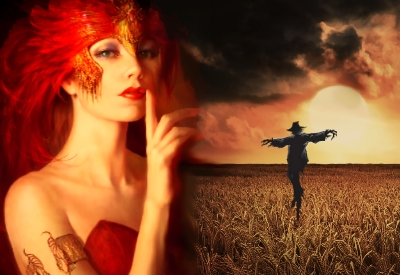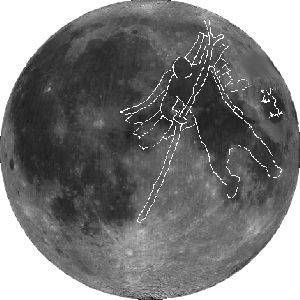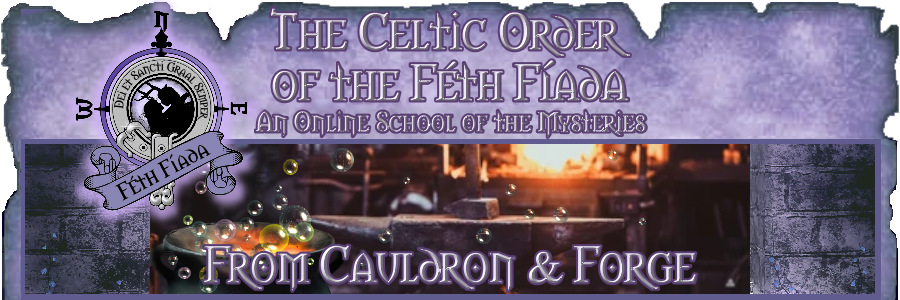
Although named for the Irish God Lugh (aka Lleu, Lugos, Lugus), Lugnasad (aka Gŵyl Awst) almost certainly ultimately derives from the Proto-Indo-European root word for his name: *leu-g- (black, dark, dim; swamp) or *leug- (bend, bow, twist) + Old Irish násad (assembly, gathering — especially one of a festive or commemorative nature; death, put to death). It most likely means the “Gathering of the Black or Bent One,” but it could also mean “Black Death” or any other such combinations thereof. However, an enormous amount of weight must be given to the first interpretation, simply because Lugnasad is still today often referred to as Black Stoop Sunday, and largely connected with an Irish deity called Crom Dubh (Black Bent One or Dark Bowed One, etc.). This figure is associated, as well, with the Irish God Crom Cruach (Bent or Bowed One of the Mound or Stack [of Grain]), to whom the people made sacrifices in exchange for milk and grain.
Thus, it would seem that both Crom Dubh and Crom Cruach were actually similar or identical to Lugh, who was also known as the “faery cobbler” Lugh Chromain, usually translated as meaning “Little Stooping Lugh,” from cromm (bent, stooped, crooked) + án (diminutive suffix). However, given what I know of Lugh, I suggest that the correct translation is actually “Black or Bent One of the Sickle,” from *leu-g- (black, dark, dim; swamp) or *leug- (bend, bow, twist) + crommán (hook, reaping-hook, sickle). Far from the tall, glorious golden Sun God that Lugh is sometimes described as being, he is instead small, dark, compact, and “crooked backed,” i.e., bent, bowed, or stooped beneath the weight and wealth of all the golden sheaves of grain he has gathered or harvested — hence “Lugnasad,” which can also be interpreted as “Lugh’s Gathering,” one of the puns so beloved by the Celts, meaning both Lugh’s assembly/gathering and Lugh’s gathering of the harvest.
In his guise as the faery cobbler, Lugh further devolved into the leipreachán < lupracán < Luchorpán (often translated as Lugh of the Small Body) and leithbrágan < Leath Bhrógan (Little Half-Brogue or Half-Shoe; figuratively, Cobbler, Shoemaker). Like the Greek Hermes and the Roman Mercury, Lugh was strongly associated with shoes (particularly with brogues — low-heeled country boots or shoes with decorative perforations or “broguing” along the visible edges), for traveling between the Worlds.
It has frequently been suggested that from Luchorpán derives the word “leprechaun,” which figure was originally Lugos with his herald’s staff (caduceus) and merchant’s sack of coins, but which god eventually shrank over the millennia into the faery cobbler with his shillelagh and pot o’ gold at the end of the rainbow. However, it should be noted that beginning in 2012, new research by Jacopo Bisagni, Michael Clarke, and Simon Rodway proposed connecting the word “leprechaun” instead to the Roman Luperci (Brothers of the Wolf), who ran naked through the streets of Rome during the Lupercalia (Wolf Festival). So it’s highly interesting that Lugos was associated with both dogs and wolves, as well.
It was, of course, Lugos or Lugh who brought the August rains and storms (and rainbows) on or around Lugnasad, to break the fiery back of summer, lest all the crops burned up in the fields before they could be harvested. To accomplish this, Lugh fought a mighty battle with Balór na Súile Nimhe (Balor of the Evil, Poisonous, or Venomous Eye). With either his slingshot or spear, Lugh slew Balór by putting out his scorching Evil Eye (the relentless, blazing Sun). The Milky Way was known as Lugh’s Chain, and his cloich tabaill (slingstone) or táthluib or táthlum (slingstone made of cement) was described as being fashioned of the “bloods collected from toads, bears, the lion, vipers and the neck-base of Osmuinn, mixed with the sands of the Armorian Sea and the Red Sea,” or else as a “concrete ball, made of his [Lugh’s] enemies’ brains hardened with lime.” It seems likely that Lugh’s slingstone was, in reality, the Moon, something else with which he is also associated: Gallo-Brittonic *lugra < Proto-Celtic *lugo-ra- (radiant, shining moon) and Irish lughna (moon):
A tathlum, heavy, fiery, firm,
Which the Tuatha Dé Danann [People of the Goddess Danu] had with them,
It was that broke the fierce Balór’s eye,
Of old, in the battle of the great armies….
To the hero Lugh was given
This concrete ball — no soft missile —
In Mag Tuireadh [the Plain of Towers] of shrieking wails,
From his hand he threw the tathlum.
Ancient Europeans saw a man, bent or stooped beneath his harvest burden, on the face of the Moon; it is he who was the original “Man in the Moon,” often accompanied by his dog.

Thus, if Lugh has any connection to the Sun at all, it is almost assuredly only to the pale, sickly winter Sun, which sometimes resembles the Moon. He is the psychopomp who guides the Souls of the Dead to the Underworld (remember his shoes, for traveling between the Worlds). His riches are the harvests he gathers, and life itself — the latter the steep price one must pay to learn the secrets of his Sacred Mysteries.
As Lugh is the beginning of the end for Balór and for us, so Lugnasad is a threshold or liminal time, the beginning of the end of the Light Half of the Year. From the standpoint of the seasons, it is the first day of autumn, and the First Harvest. The Great Mother’s milk no longer flows freely. Tailtiu (Great One of the Earth), Lugh’s foster mother, who plowed the Great Plain, has died of exhaustion from her labors, and Lugh, in his grief (note the Proto-Indo-European *leug- “grieve, be pained”), has established his Festival of Gathering to honor her memory, complete with an assembly of the people and a plethora of funeral games. The old name of this festival was, in fact, Brón Trogain (Earth’s Sorrow), for at this time, Earth gives birth to the first fruits of her labor, so her children may live. It is a metaphor based on the labor of childbirth.
Lugh himself is the Winter Lord, the Grim Reaper, accompanied by the crows and ravens (he is also associated with an ill-attested Gaulish lugos “raven”) that scavenge the cornfields, battlefields, and other places of Death; and the Summer Lord, once the “scare-crow,” is now no more than the straw- or wicker-man, who will soon be dead and burned.
Lugnasad is not only the time to give thanks for the First Harvest, but also to recognize that just as the crops give their lives to ensure our survival, so we, too, will give our own lives in the end — perhaps to ensure the survival of something even greater than we are. But this is a Mystery that we cannot know fully until we ourselves have passed through the Gates of Death to the vast, unknown Beyond.
From the first gatherings of the harvest, offerings were made to Lugh; a bull was sacrificed to him, as well, to be eaten at the harvest feast shared by the community. This was also the time when berries (especially bilberries) were picked, and when many handfastings (a-year-and-a-day trial marriages) took place (humankind has a great, instinctive urge to “make life” in the face of Death). Pageants and plays were performed, too, replete with storytelling, dancing, and ritual fighting. A carved stone head was installed atop a hill, and the actor portraying Lugh triumphed over it (in some tales, instead of putting out Balór’s Evil Eye, Lugh beheads him, setting the head on a large rock, which is subsequently shattered by it).
Pilgrimages called “rounding rituals,” which involved praying while walking sunwise around features on Croagh Patrick (Patrick’s Stack), located in County Mayo, Ireland, and known locally as “The Reek” (Rick or Stack; hence Reek Sunday), were carried out by both the devout and the penitent. Believed to be at least 1,500 years old, such pilgrimages pre-date Christianity and were originally associated with Lugnasad.
In addition, the best athletes and warriors from miles around gathered for the funeral games. Oaths were sworn and contracts and trade agreements undertaken. Among many other things, Lugh was a God of Oaths and Commerce, and some scholars have suggested the former as the origin of his name: Old Irish luige (oath, vow, act of swearing) < suffixed Proto-Celtic form, *lugiyo- (oath).
During Lugnasad, people also visited holy wells, bringing with them coins and/or strips of cloth called “clooties,” which were used in blessings and healing for the sick. The coins were often hammered into the trunk of the sacred tree at the holy well, and the clooties tied around its branches, the theory being that as the cloth weathered and wore away, so the sick person’s illness would wear away, as well. Lugnasad’s alternative name of Garland Sunday stems from the tradition of decorating such holy wells with garlands of flowers at this celebrated time.
Blessings!
APs Rhianwen Bendigaid
Sources:
“All about Lughnasadh,” Claddagh Design. Web.
“Balor,” “Croagh Patrick,” “Crom Cruach,” “Crom Dubh,” “Lammas,” “Leprechaun,” “Lugh,” “Lughnasadh,” and “Reek Sunday,” Wikipedia. Web.
The Festival of Lughnasa, Máire MacNeill, Folklore of Ireland Council, 1962, reprint 1983, 2008; ISBN: 9780906426104.
In Nature’s Honor: Myths and Rituals Celebrating the Earth, Patricia Montley, Skinner House Books, 2005; ISBN: 9781558964860.
Lammas: Celebrating the Fruits of the First Harvest, Anna Franklin, Llewellyn Publications, 2001; ISBN: 9780738700946.
“Leprechaun: A New Etymology,” Jacopo Bisgni, Cambrian Medieval Celtic Studies 64 (Winter, 2012): 47–84.
Lughnasadh: Rituals, Recipes & Lore for Lammas, Melanie Marquis, Llewellyn Publications, 2015; ISBN: 9780738741789.
“Lugus: The Many-Gifted Lord,” Alexei Kondratiev, An Tríbhís Mhór: The IMBAS Journal of Celtic Reconstructionism #1, Lúnasa 1997.










